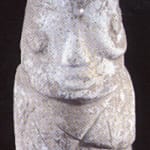Neolithic Marble Figure, 3300 BCE - 2050 BCE
Marble
6.75 x 13.25
H.511
Many thousands of years ago, our earliest ancestors were nomadic tribes that survived by foraging the wild for food and shelter. During the Neolithic era, human groups first began to...
Many thousands of years ago, our earliest ancestors were nomadic tribes that survived by foraging the wild for food and shelter. During the Neolithic era, human groups first began to settle down permanently, establishing villages and communities. However, without new technological innovations, this sedentary culture would not have been possible. Foremost among these discoveries were agriculture and tool-making, both of which enabled humans to transform their natural environment into a sustainable society. Many thousands of years ago, the area presently covered by modern China was made up of distinct regions each with their own unique cultural identity. Archaeologists have been able to discern some of these cultures from each other based upon the burial styles, architecture, and pottery, perhaps the most immediate remnant of this age.
This marble carving of a human figure is one of the earliest examples of human images uncovered in China to date. Its origins are still shrouded in mystery, but it is likely that it represents an image of a female as the ancients believed the ritual practice of deference to fertility deities would ensure prosperity. Images of goddess figures suggest acknowledgment of the important role women played in the development of agriculture and animal domestication. This pillar shaped statue has a flat bottom and smooth surface with patches of earth attached in areas. Incised lines depict a person with arms extended over the chest, perhaps kneeling in a posture of reverence. The head is disproportionately large; lines above its squinted eyes represent hair. The bridge of the nose is long, characteristic of Northern cultures, and two bulges protrude from the sides of the face. A fine example of early man's belief in the power of reproduction reified in the body of women, this piece reminds us of our common belief in the origins of man.
This marble carving of a human figure is one of the earliest examples of human images uncovered in China to date. Its origins are still shrouded in mystery, but it is likely that it represents an image of a female as the ancients believed the ritual practice of deference to fertility deities would ensure prosperity. Images of goddess figures suggest acknowledgment of the important role women played in the development of agriculture and animal domestication. This pillar shaped statue has a flat bottom and smooth surface with patches of earth attached in areas. Incised lines depict a person with arms extended over the chest, perhaps kneeling in a posture of reverence. The head is disproportionately large; lines above its squinted eyes represent hair. The bridge of the nose is long, characteristic of Northern cultures, and two bulges protrude from the sides of the face. A fine example of early man's belief in the power of reproduction reified in the body of women, this piece reminds us of our common belief in the origins of man.
Literature
V17



